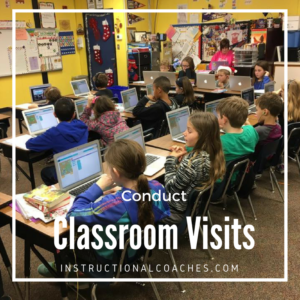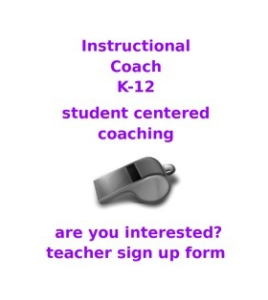Build Relationships Through Classroom Visits:
Let teachers know that you value what they are currently doing in their classrooms. Give them recognition for the successes that they are already seeing with their students. The best way to build relationships, with teachers you have been teaching along side or are meeting for the first time, is to conduct classroom visits to showcase the AWESOMENESS.

There are 43 elementary teachers in my district. My goal was to visit each and every one of them. I mean, how often as a classroom teacher do you get to watch another classroom in action? As a 3rd-grade teacher, I had no idea of how the other teachers ran their classrooms, the great ideas they were implementing or classroom management techniques that were working for them. I also needed to get a feel for how all of the other grade levels and subject areas worked.
I started my coaching by conducting “classroom visits” (not observations) to get a feel for how I could help. I found out the hard way that the word “observation” was a no no! A HUGE takeaway that I had from reading the Jim Knight books was that Instructional Coaches ARE NOT evaluators, rather teaching partners. We have teaching contracts and should be viewed as another teacher. To most of my teachers, the word “observation” felt evaluative. So, I chose to call my visits “classroom visits”. It was much less threatening than “observation”. I have also heard them called pop ins. This is the form that I started with.
Classroom Visit Advice:
My advice to a new Instructional Coach is to stay far away from the O word and make sure that teachers know when you are going to be visiting. Nothing gives teachers more anxiety than a random, unexpected visit, especially if classroom visitors are new to the workings of the school culture. Scheduled visits are best to start with. As the culture changes and teachers get used to others in their classrooms, visits can be more organic. DO NOT WRITE ANYTHING DOWN IN THE CLASSROOM!!!!!!! Do not bring anything into the classroom with you. Don’t take any notes, other than mental notes. This piece is SUPER important. Writing things down during classroom visits is another HUGE factor of teacher anxiety. The goal of classroom visits at first is to get teachers and students comfortable with others in their classrooms. At the same time, get the coach comfortable with the day to day happenings in the classrooms.
Classroom Visit Sign Up:
I created a Google spreadsheet and had teachers fill in the days and times that worked best for them for me to visit. This was a nightmare to keep up with. I had 43 teachers to try and visit. I was constantly checking it since it didn’t alert me when something new was added. I would have used a Google calendar, but I knew most of the staff didn’t know how to use this feature. After a year of using a spreadsheet to keep track of my schedule, I decided it was best to find some time within one of our staff PD days to teach the staff how to use a Google calendar. It was well worth it! I mean, don’t get me wrong, I still have teachers that can’t remember how to sign up on my Google calendar, but very few. I suggest to them to send me an email after they sign up on my calendar to ensure that it made it on. I have only missed a few teachers (because they thought they knew what they were doing and accidentally put it on their own Google calendars). I would definitely suggest starting with a Google calendar! It may take a little work up front, with teaching teachers how to use it, but it is well worth it! I helped teachers collect and organize data for their PLC’s, helped plan student interventions with that data, created digital resources, taught a few genius hour groups, helped with the implementation of our new online programs (including running staff PD’s) and taught many technology tools (and how they could be used) in the classrooms. I was in the role of a consultant my first year as an instructional coach, I just wasn’t aware that I was. (Please see my next blog entry for the difference between a coach and a consultant).
*This post may contain affiliate links

